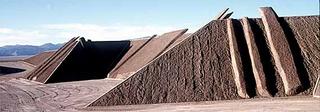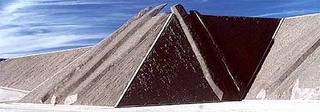Geotechnics
Direct intervention into the earth's surface through technology – the coupling of the planet with technological objects – could be phrased as 'geotechnical,' a word I thought I invented – until I discovered that 'geotechnics' is already a long-standing professional concern of engineers and architects. Gone was the whiz-bang neologism, but born was an intense curiosity in what 'geotechnical engineers' actually do.
Unforeseen ground conditions. Reuse of old foundations. Ground investigation. Geological voids. Borehole geophysics. 'Geo Frontiers 2005'. Ground engineering, which includes 'international geotechnical events' and 'covers all aspects of the engineering of the ground'.
The vocabulary alone justifies awe. Where else can you read: 'Sui Field compression project: the tectonic structure of Northern Pakistan', and take it seriously?
Geosynthetics!
Ground improvement!
'The geotechnics of contaminated land'!
Applied geology.
My enthusiasm coming here not from some pre-adolescent obsession with digging machines, but from the black-out inducing intellectual high of outright planetary engineering, a geosynthetic *Wunderproject*, where remote-sensing meets hydrological engineering, geotextiles, ground improvement, and mega-scale, antigravitational, interstellar industrial machines hovering 350 miles above the dark, unfinished surface of a geoengineered planet.
'The engineering of the ground'!
After geotechnics, the whole planet could be already artificial, bearing marks of human intervention. To find in a moment of ultra-fast zoom-out cello-soundtracked awe that the earth you're standing on is always, already, everywhere a huge Mt. Rushmore, a man-made, artificial, technological, geotechnic project.
A hollow earth, a geosynthetic planet. Sculpted from geotextiles.
Landscape architecture taken to the megalomaniacal extreme. And funded by multinational petroleum companies.
Unforeseen ground conditions. Reuse of old foundations. Ground investigation. Geological voids. Borehole geophysics. 'Geo Frontiers 2005'. Ground engineering, which includes 'international geotechnical events' and 'covers all aspects of the engineering of the ground'.
The vocabulary alone justifies awe. Where else can you read: 'Sui Field compression project: the tectonic structure of Northern Pakistan', and take it seriously?
Geosynthetics!
Ground improvement!
'The geotechnics of contaminated land'!
Applied geology.
My enthusiasm coming here not from some pre-adolescent obsession with digging machines, but from the black-out inducing intellectual high of outright planetary engineering, a geosynthetic *Wunderproject*, where remote-sensing meets hydrological engineering, geotextiles, ground improvement, and mega-scale, antigravitational, interstellar industrial machines hovering 350 miles above the dark, unfinished surface of a geoengineered planet.
'The engineering of the ground'!
After geotechnics, the whole planet could be already artificial, bearing marks of human intervention. To find in a moment of ultra-fast zoom-out cello-soundtracked awe that the earth you're standing on is always, already, everywhere a huge Mt. Rushmore, a man-made, artificial, technological, geotechnic project.
A hollow earth, a geosynthetic planet. Sculpted from geotextiles.
Landscape architecture taken to the megalomaniacal extreme. And funded by multinational petroleum companies.








